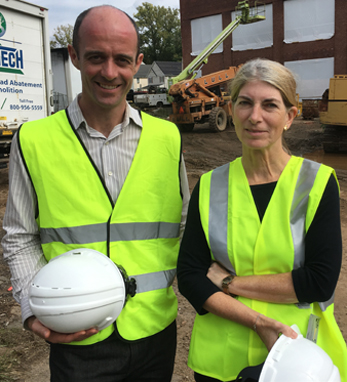
Rosanne Haggerty
When Rosanne Haggerty was a girl, her family went to a church in downtown Hartford that was across from a worn, single-room-occupancy (SRO) rooming house. Over time the Haggertys got to know some of the residents, even invited them to their home for holiday meals.
It was an introduction to the importance of housing for the poor and lit the spark of what has become a remarkable career. First, Haggerty pioneered “supportive housing,” housing with treatment, counseling, and other services on the site. Now she is taking on the broader issue of homelessness – and making progress.
After building affordable housing for Catholic Charities in Brooklyn, she chanced on an opportunity. The once-grand Times Square Hotel in midtown Manhattan had fallen on hard times when Times Square itself went seedy in the 1960s and ‘70s.
Long story short, she formed a nonprofit, Common Ground Community, in 1990 (at age 29), gained control of the hotel and renovated it. The hotel reopened in 1994 as the largest supportive housing community in the country. Half of the more than 650 residents of the Times Square Hotel are low-income working people, actors and artists, shop workers, etc. The other half, were formerly homeless people.
The success of the Times Square and other projects brought her national recognition: a MacArthur Genius Grant in 2001, two appearances on “60 Minutes,” etc.
But as she continued building housing for the homeless, it dawned on her that she was still seeing the same homeless people on the street, year after year. “We’d open a building, rent it up, and the people would still be out there,” she said in a recent interview.
So she began to look at the workings of New York City’s homeless system and found it “a bureaucratic nightmare.” The parts weren’t connected.
For example, outreach workers were contracted to make “contact” with the homeless and offer food or rides to shelters – not help them find a home. Those who didn’t want to go to shelters weren’t even officially considered homeless, and were thought not to want housing. Haggerty sent staffers out to interview scores of homeless folks and found that they did indeed want “a place of their own – small, private, clean, safe space no questions asked.”
She came to realize that the people moving into her buildings were not necessarily the most needy, but those who had social workers and were good “self-advocates.” Many of the others were falling through the fairly large cracks.
Haggerty started thinking about what drove homelessness. She studied models in England and Japan. She observed that if resources spent on crisis services for the homeless were redirected, the problem could be reduced, even solved. But communities did not coordinate their resources, or have any way of tracking whether their efforts were leading to fewer people experiencing homelessness.
In the two decades after it was founded, Common Ground (now Breaking Ground) created more than 3,000 units of supportive and affordable housing, and served more than 4,500 people.
But Haggerty now saw that programs operating alone could not make a significant impact, and that homelessness required a community wide approach.
In 2011 she spun off a new nonprofit, Community Solutions, Inc., to help communities end homelessness. Her “Built for Zero” team of data analysts and improvement coaches works with more than 60 U.S. communities to build coordinated local systems that will make homelessness rare, and brief. She involved other sectors and nonprofit agencies that receives federal funds for the homeless and the housing authority, who became the core members of the team. These teams learn to be accountable to each other, to set tough deadlines, and to use real time, person specific data, to get the job done.
Her people are also developing new types of housing for communities that have gaps in housing supply: A “well-run Y.M.C.A” is one model. Thus far, Community Solutions has had a hand in housing more than 200,000 people in the U.S. since 2011, and more in Canada.
The goal is to prevent homelessness through greater collaboration between employment, health and other services, and also to learn about neighborhoods, what makes them succeed or fail. Haggerty, who exudes intelligence and confidence, but also humility, says, “We’re still learning.” – Tom Condon ♦
